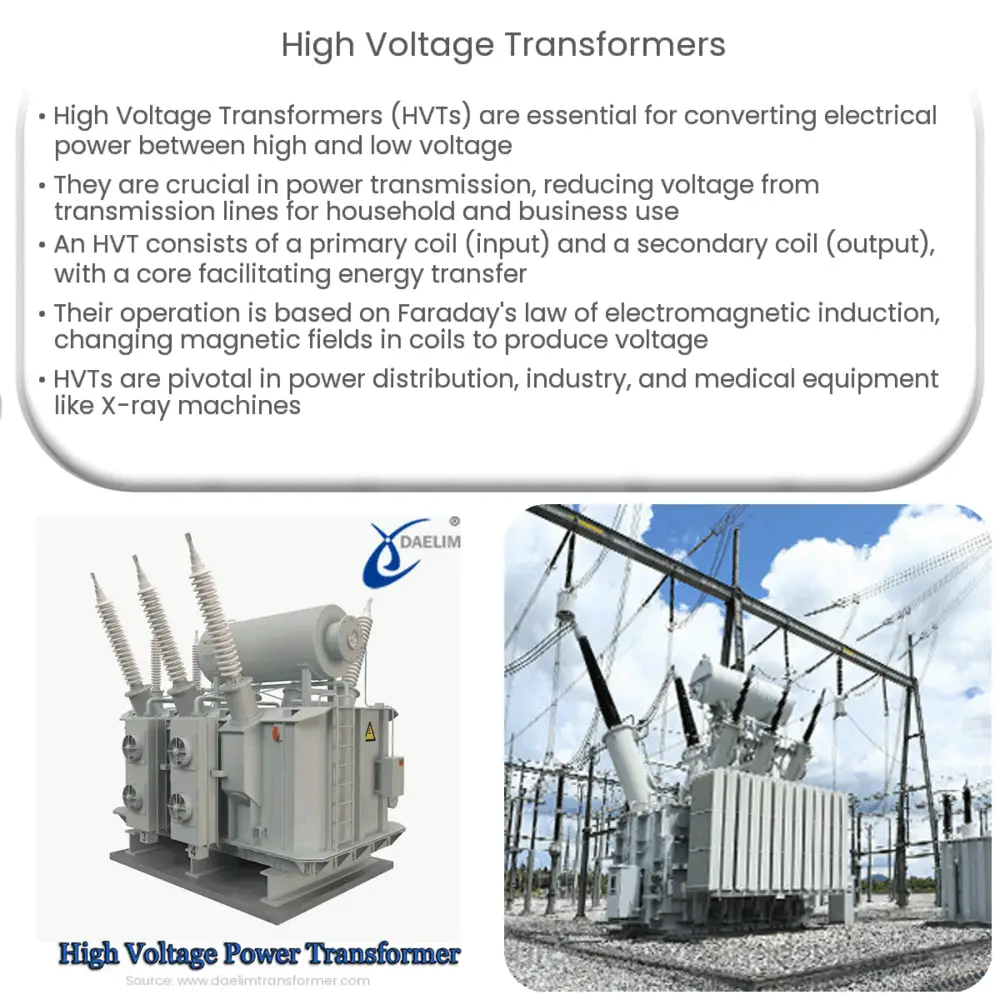Explore the functioning, components, types, safety measures, and applications of high voltage transformers in our comprehensive guide.

Understanding High Voltage Transformers
Transformers are integral components of any electrical network. They function as power transfer devices, transforming voltage levels from one stage to another. The scope of this article focuses on a specific type of transformer: High Voltage Transformers (HVTs).
Role and Functionality of High Voltage Transformers
High voltage transformers are specially designed transformers used to convert electrical power from high to low voltage or vice versa. The primary application of these transformers is in power transmission networks, where they step down the voltage from high voltage transmission lines to levels that can be used in homes and businesses.
Components of High Voltage Transformers
Understanding the components of HVTs provides insights into their working principles. An HVT comprises primarily of two coils: the primary coil and the secondary coil.
- Primary Coil: This coil is connected to the input voltage source. In the case of a step-down transformer, the primary coil will be connected to a high voltage source.
- Secondary Coil: This is the output coil, connected to the load. It provides the transformed voltage, which, in the case of a step-down transformer, will be significantly lower than the input voltage.
Besides these, an HVT also includes a core. The core serves as the magnetic pathway facilitating the transfer of energy between the two coils.
Operating Principles of High Voltage Transformers
The operation of high voltage transformers is based on Faraday’s law of electromagnetic induction. It states that a change in magnetic field within a coil will induce an electromotive force (EMF) in a neighboring coil.
In the case of an HVT, when a high voltage is applied to the primary coil, it creates a strong magnetic field around it. This field cuts across the secondary coil, inducing a voltage. The magnitude of this voltage depends on the turns ratio, which is the ratio of the number of turns in the primary coil to the number of turns in the secondary coil.
Mathematically, this can be represented as:
VP / VS = NP / NS
where, VP and VS are the primary and secondary voltages, and NP and NS are the number of turns in the primary and secondary coils, respectively.
Types of High Voltage Transformers
High voltage transformers can be categorized into different types, each designed to meet specific needs and applications.
- Power Transformers: These are used in transmission networks for stepping up or down voltage levels. They have a high voltage rating and a capacity of more than 33KV.
- Distribution Transformers: Used in distribution networks of power supply companies and industrial plants. They have lower voltage capacity than power transformers.
- Instrument Transformers: These are specifically designed for monitoring and protective applications in power systems.
Safety Measures in High Voltage Transformers
Given the high voltage levels involved in HVTs, various safety measures are in place to prevent accidents and ensure smooth operation. This includes insulation between the primary and secondary coils, protective casings, and grounding of the transformer body. Additionally, proper maintenance and regular inspections are vital for ensuring the longevity and safety of the HVT.
Applications of High Voltage Transformers
High voltage transformers play a critical role in various sectors. In the power sector, they are used in power plants and substations for power transmission and distribution. In the industrial sector, they’re used in manufacturing processes that require high voltage, such as smelting and welding. HVTs also find applications in medical equipment, like X-ray machines, which require high voltage to operate.
Conclusion
In conclusion, high voltage transformers serve as the backbone of our modern power transmission and distribution systems. They function to safely and effectively transform voltage levels, facilitating the delivery of power from generation sites to end users. The design and operational principles of these transformers are grounded in fundamental laws of electromagnetism, illustrating the seamless blend of scientific theory and practical application.
As our energy needs evolve and grow, so too will the role of high voltage transformers, underscoring their importance in maintaining and improving our power infrastructure. Understanding the intricacies of these devices is vital for anyone involved in the electrical and power sectors, whether as a professional or a consumer. By continuing to improve these critical devices, we can look forward to a future of more efficient, reliable, and sustainable power delivery.

